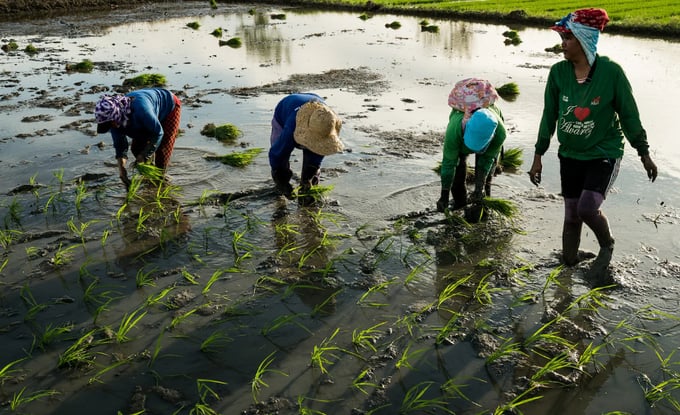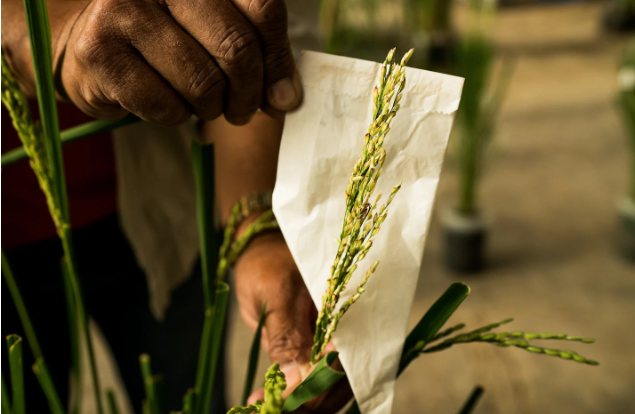May 16, 2025 | 21:24 GMT +7
May 16, 2025 | 21:24 GMT +7
Hotline: 0913.378.918
May 16, 2025 | 21:24 GMT +7
Hotline: 0913.378.918

As more farmers use machinery in their fields, the outlook for contract farmers who work on others' fields is bleak.
NUEVA ECIJA, Philippines — In the Philippines, people say, “Bigas ay buhay”: “Rice is life.” It’s a neutral canvas for every meal. Other foods are often served as “ulam,” the topping or side dish for rice. Rather than unlimited soda, fast-food chains serve “unli-rice.”
It’s boiled into language. There’s tutong (burned rice), bigas (uncooked rice), kanin (cooked rice), palay (unhusked rice), am (rice water) and bahaw (day-old rice). Rice missing from a meal is almost an accusation: You’re committing papak.
Some 2.4 million Filipinos work as rice farmers, toiling on lush paddies that blanket the country, some on ancient terraces that cut through steep hills. But for young people, the grueling, volatile and often impoverished life of a rice farmer holds dwindling appeal. With fewer young people willing to farm, the average age of a Filipino rice farmer is 56 — and climbing.
The shift away from farming could mean food shortages in the Philippines, which already imports more rice than any other country. Policymakers are scrambling: Upon taking office, President Ferdinand Marcos Jr. promised to boost the agriculture sector, even appointing himself agriculture secretary, but those efforts have largely stalled. Rice inflation reached a 15-year high in the spring. Last week, Marcos Jr. formalized a cut in tariffs on imported rice from 35 percent to 15 percent — an effort to ensure food security in the country. Farmers, however, said the move was yet another sign of neglect.
“If our farmers die in the next 20 years … who will feed the Filipinos?” said Jett Subaba of the Philippine Center for Postharvest Development and Mechanization, or PhilMech. “It’s not just something optional to address. … When we talk about food, we talk about life, right?”
In Nueva Ecija, a province north of Manila, rice is everywhere. Neon-green rice paddies line highways. Hulking plow-pulling water buffaloes known as “carabao” plod through traffic. Here, Privado Serrano spends searing afternoons in knee-deep mud, bending to sow seeds in neat rows. It requires endurance, agility and a very good back.
Privado is 66.
He has been farming rice since age 10. His father was a rice farmer, as were generations before him. Privado’s two sons are rice farmers. His only daughter married a rice farmer, too.
But Privado’s grandchildren want a different life.
“I just don’t like it,” Arvin, 23, said of rice growing. He doesn’t like the sun, he added, or lifting heavy things. “Sometimes, I feel lazy.”
“At least he’s honest,” his aunt said.
Arvin knew this from a young age, so he studied criminology at a local college and graduated this year — a family first.
For years, he watched his family toil, fall into debt and lose sleep over natural disasters.
“If the rice falls over, wala na — it’s over,” Privado’s son Arturo said, recalling Typhoon Karding, which in 2022 bulldozed the family’s crops only two weeks before harvest.
Rice farmers net an average of $294 per hectare (about 2½ acres) per biannual crop season, after high upfront production costs.
Returns vary because of weather, but also the volatile price of rice. The trade of rice globally is a relatively small proportion of total rice produced, said Nafees Meah, who previously served as Asia director at the Philippines-based International Rice Research Institute (IRRI). “So the margin is tight. … If you time it wrong, the price rockets.”
For many in the Nueva Ecija municipality of Talavera, the Serrano family’s hometown, where 80 percent of the land is agricultural, becoming anything but a farmer is seen as a ticket out.
A shop produces custom metal signboards for proud parents to proclaim it on their homes’ facades: Myla S. Paragas, Registered Nurse.
When Privado’s son first followed him into the paddies, he felt happy. He wanted them to one day inherit his 17-acre plot. Now, knowing the job’s volatility and the gulf between effort and reward, he regrets it. “This time, I’m so sad if I see he’s farming. I feel so bad.”
Andrea, 10, one of his grandchildren, wants to go to medical school. Just standing in the paddies for two minutes, Andrea and Arvin squint and complain.
Privado is quick to say his back doesn’t hurt from decades of rice planting; in fact, it’s made him age more gracefully. At his age, his eyes, now cloudy, are the problem. Andrea administers her grandfather’s eye drops. The Serranos all say she’ll become the family’s first doctor.
The value of farmland plots land in Nueva Ecija is soaring, as private commercial developers scoop up land. Privado bought his first plot two decades ago for about $5,100, then $8,600, then his last at $17,000. He can’t afford to continue expanding.
For the industry’s many contractors, the outlook is bleaker still.
Dotting the pastoral scene with neon colors, Nelia Ipo, 61, and about a dozen mostly elderly farmers wrap shirts around their heads to ward off sunrays. Ipo, who’s been working other people’s fields since age 9, treads backward in the silky mud. It’s covered in a veneer of flies.
“If there is a machine, we don’t have work, we don’t have money, we don’t have livelihood. We are miserable,” she said.
Marcos Jr. pushed for agricultural modernization, distributing farm equipment and writing off $1 billion in farmers’ debts. But he has also implemented measures that made the lives of rice farmers far harder, including a price ceiling on rice in a bid to tamper down rising inflation.
Amid soaring food costs, he relinquished his agriculture chief post in November and reversed his decision on a price ceiling, saying at the time: “Agriculture is much, much more complicated than what people understand.”

A researcher at the IRRI shows a new rice variant that is undergoing development.
Some bodies want to promote an entrepreneurial view of farming. With government funding, PhilMech promotes using farm machinery.
“If before, farmers’ best friend is a carabao, today it’s machines,” PhilMech’s Subaba said. Farmers can listen to Spotify while driving transplanters, he added. “We’re giving them the image that it’s cooler today.”
There are other ways technology can help. At IRRI’s gene bank, walk-in freezers hold 132,000 varieties and wild species of rice. Scientists are using gene editing to harness an “elite breeding pool” to create rice varieties that can resist drought, floods and the cold, or are enriched with iron and zinc.
While some raise alarm bells at the younger generations’ retreat from the rice fields, other experts say it isn’t all bad, given economies of scale; the shrinking of the sector is a welcome, even necessary, step. Fewer, more-productive young farmers will carry the torch, they argue.
In the Philippines, most farm holdings are very small, averaging 1.5 hectares (under 4 acres) — part of a legacy of 20th-century land reform that limited holdings. The average size of an Australian farm is over 4,000 hectares (about 10,000 acres).
David Dawe, a former U.N. Food and Agriculture Organization senior economist, said that across countries, as economies grow, the share of the workforce involved in farming declines and food becomes a smaller share of total expenditure. Even as people buy more motorcycles and take more vacations, he said, “our stomachs are finite in size.”
Across the world, diets are diversifying, changing the rate of demand.
“If you’ve got too many people involved in a sector that’s contributing a smaller and smaller percentage of the total economy, then you’re condemning these people to poverty,” Dawe said.
IRRI’s Meah said he’s not so hung up on the number of Filipinos leaving farming. Instead, what bothers him is that “not enough young people see farming as an opportunity to have a fulfilling life.”
Anthropologist Florencia Palis found that two-thirds of farmers in the country did not want their children to pursue rice farming.
When asked about their profession, planters would say, “I am only a farmer,” said researchers at the government-attached Philippine Rice Research Institute (PhilRice). So it printed shirts proclaiming, “Anak ako ng magsasaka.”
That translates as: I am a farmer’s child.
(Washingtonpost)

(VAN) Fourth most important food crop in peril as Latin America and Caribbean suffer from slow-onset climate disaster.

(VAN) Shifting market dynamics and the noise around new legislation has propelled Trouw Nutrition’s research around early life nutrition in poultry. Today, it continues to be a key area of research.

(VAN) India is concerned about its food security and the livelihoods of its farmers if more US food imports are allowed.

(VAN) FAO's Director-General emphasises the need to work together to transform agrifood systems.

(VAN) Europe is facing its worst outbreak of foot-and-mouth since the start of the century.

(VAN) The central authorities, in early April, released a 10-year plan for rural vitalization.

(VAN) Viterra marked a significant milestone in its carbon measurement program in Argentina, called Ígaris, reaching 1 million soybean hectares measured.